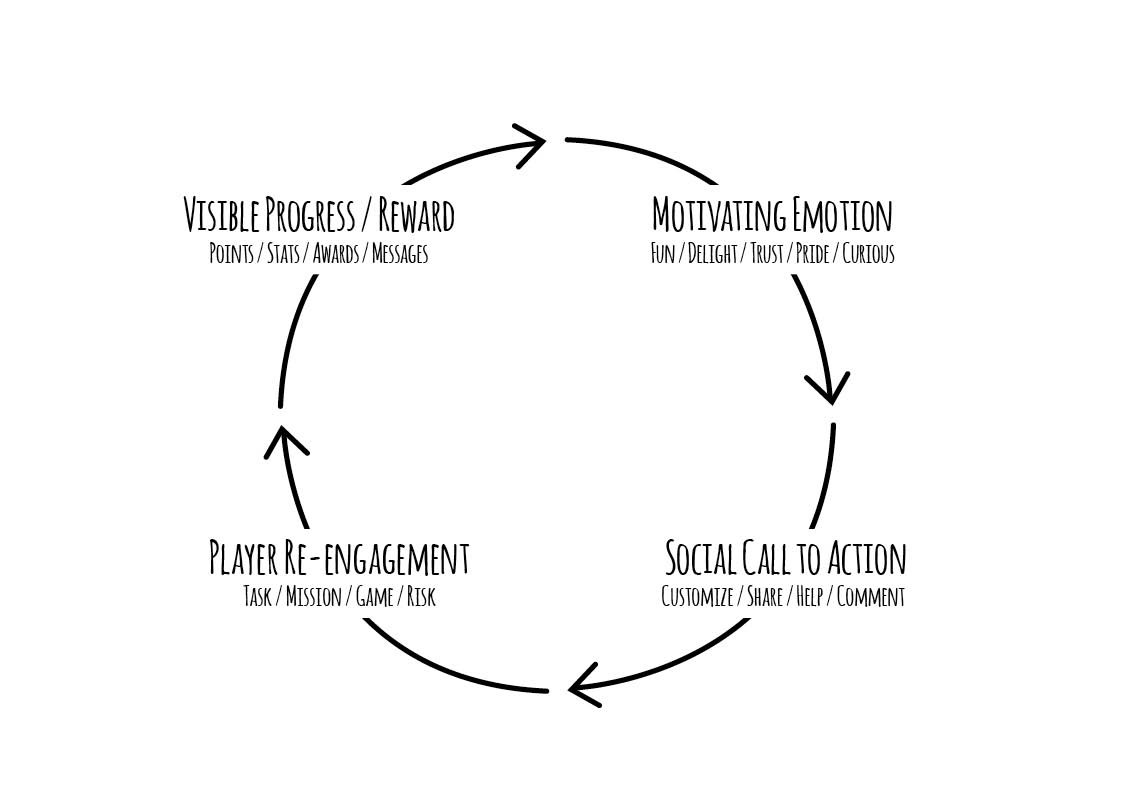There are seven basic game mechanics that should be considered when creating a gamified experience: points, levels, leaderboards, badges, onboarding, challenges/ quests, and engagement loops.
Points
In order to motivate the player to take certain actions in alignment with the behavioral objectives, each action should have a certain point value assigned to it. These points should be part of the experience point system which is important to rank and guide players through the game. Other point systems that can be included in a game are redeemable points, which are used to create a virtual economy and are used as „currency“ within the system, skill points which are assigned only to specific activities alongside the core storyline or objectives to develop an additional skillset. Moreover, there are karma points, whose only purpose is to spend them and reputation points which are the most complex point system as they are used to create credibility and trust.
Levels
Levels are usually an indicator of progress and help the players orient where they stand in a gaming experience over time. The difficulty of the levels should not be linear nor exponentially – rather the complexity should align with the player progress. Which will usually be steeper in the beginning flatten out over time, become steeper again and so forth. If players progress rather seamlessly throughout the game they will gain confidence and experience and thus more engagement. An unexpectedly difficult level can then be used to create a feeling of major accomplishment and becoming part of an exclusive group. However, this could also lead to dropouts by those who find it too challenging.
Besides difficulty, levels can also define the game’s leading element or as a passive marker create more depth and complexity to the game. Levels should always be logical, extensible beyond the initial „boss“ level, flexible and finally testable and refinable.
Leaderboards
The purpose of leaderboards is the simple and self explanatory comparison of players. As mentioned in a previous entry it is important not to discourage players by shaming those who are not so great at the game. There are two main ways to keep them motivational: the non-disincentive board where players are always placed in the middle of the screen only showing a couple places right ahead and behind them. The other way is the infinite leaderboard where players are never truly kicked off the leaderboard creating the option of slicing the board f.e. locally, socially and globally.
Badges
They signal the completion of goals and thus progress in the system, in some games they might even replace levels as progress indicator. For some players collectable badges serve as powerful motivator. However they should not be too common or easy to acquire as they loose their attractiveness. Ideally a balance between predictable badges, players can work towards and surprise badges should be used and they should be visually appealing in order to create a collecting-value.
Onboarding
The goal of the onboarding process is to train and engage but without getting overwhelming. Therefore it is important not to put too much information at the beginning of the game – don’t write pages of instructions. Rather create an explanatory tutorial level where players follow a basic path they can not fail at. Reveal the complexity of the game slowly and reinforce positivity. The first minute a new player engages with a game are the most important as an opinion about the game will be formed and determine if the player’s decision of continuing or dropping out. So the first minute should offer something of value to the player. Ideally the onboarding is also used to learn something about the players.
Challenges and Quests
Even if the core of the experience is not a challenge, challenges can still be used in order to create a sense of direction and goal to work towards. There should always be something interesting for players to accomplish which leads them along the path of the intended overall experience. Quests are more socially powerful if they are cooperative, either requiring actual team-play or rolling up achievements of each individual player to an entire group. Especially for gamification in e-learning collaborative quests are recommendable as mentioned in a previous entry.
Social Engagement Loops
Not only the player’s actual engagement with the system should be considered when creating a gamified experience but also how he leaves the system and what brings him back again.
In a social engagement loop, a motivating emotion leads to player re-engagement, which leads to a social call to action, which flows to visible progress and/or rewards, which loops back around to a motivating emotion.
There should be a social engagement loop at every single level of the game, they can however be very similar.
Sources:
- Zichermann, Gabe; Cunningham, Christopher; Gamification by Design: Implementing Game Mechanics in Web and Mobile Apps, O’Reilly Media, 2011
